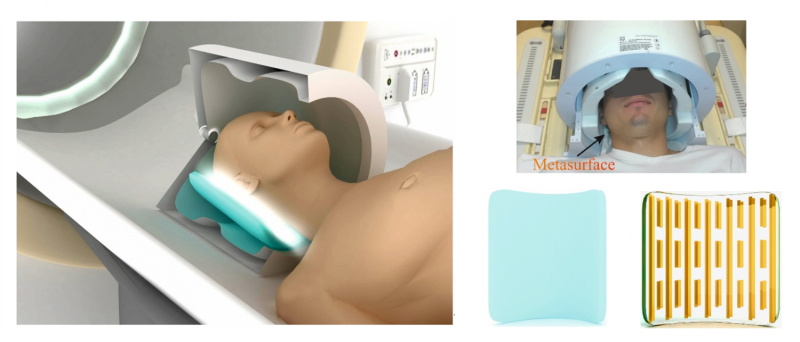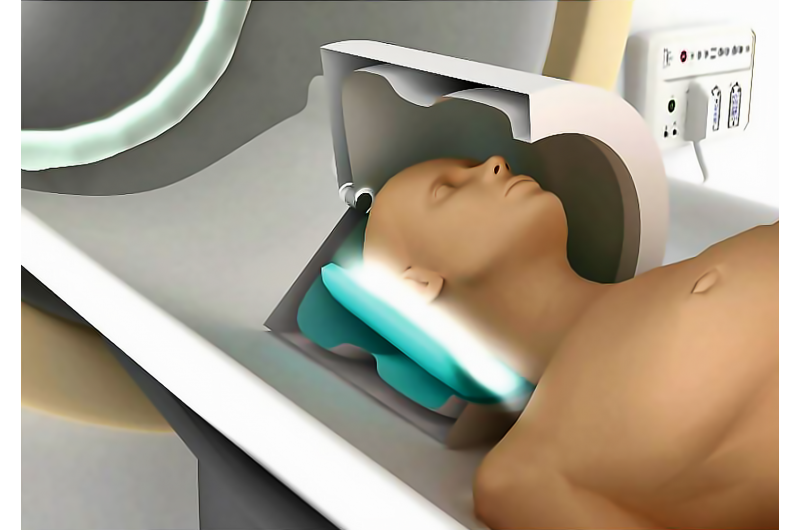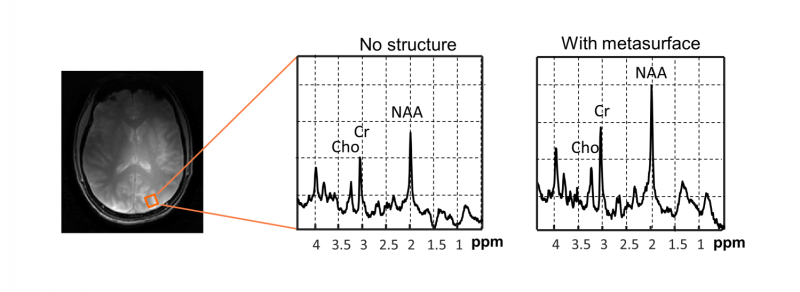Metasurface structure and application. Credit: © ITMO University
Scientists from the Netherlands and Russia have designed and tested a new metasurface-based technology for enhancing the local sensitivity of MRI scanners on humans for the first time. The metasurface consists of thin resonant strips arranged periodically. Placed under a patient's head, it provided much higher signals from the local brain region. The results published in Scientific Reports, show that the use of metasurfaces can potentially reduce image acquisition time, thus improving comfort for patients, or acquire higher resolution images for better disease diagnosis.
Magnetic resonance imaging (MRI) is a widely used medical technique for examination of internal organs, as well as playing a major role in oncology. However, due to its intrinsically lower signal-to-noise ratio, an MRI scan takes much longer to acquire than a computed tomography or ultrasound scan. This means that a patient must lie motionless within a confined apparatus for up to an hour, resulting in significant patient discomfort, and relatively long lines in hospitals.
Specialists from Leiden University Medical Center in the Netherlands and ITMO University in Russia have acquired human MRI with enhanced local sensitivity provided by a thin metasurface—a periodic structure of conducting copper strips. The researchers attached these elements to a thin flexible substrate and integrated them with close-fitting receive coil arrays inside the MRI scanner.
"We placed such a metasurface under the patient's head, after that, the local sensitivity increased by 50 percent. This allowed us to obtain higher image and spectroscopic signals from the occipital cortex. Such devices could potentially reduce the duration of MRI studies and improve its comfort for subjects," says Rita Schmidt, the first author of the paper and researcher at the Department of Radiology of Leiden University Medical Center.
A patient in MRI scan modified by metasurface. Credit: © ITMO University
The metasurface, placed between a patient and the receive coils, enhances the signal-to-noise ratio in the region of interest. "This ratio limits the MRI sensitivity and duration of the procedure," notes Alexey Slobozhanyuk, research fellow at the Department of Nanophotonics and Metamaterials of ITMO University. "Often, the scans must be repeated many times and the signals added together. Using this metasurface reduces this requirement. Conventionally, an examination that now takes 20 minutes may only need 10 in the future. A hospitals that serves 10 patients a day will be able to serve 20 with our development."
Alternatively, according to the scientists, the metasurface could be used to increase the image resolution. "The size of voxels, or 3-D-pixels, is also limited by the signal-to-noise ratio. Instead of accelerating the procedure, we can adopt an alternative approach and acquire more detailed images," says Andrew Webb, the leader of the project, professor of radiology at Leiden University Medical Center.
MRI image made with and without metasurface. Credit: © ITMO University
Until now, no one has integrated metamaterials into close-fitting receive arrays because their dimensions are much too large. The novel ultra-thin design of this metasurface helped to solve the issue.
"Our technology can be applied for producing metamaterial-inspired, ultra-thin devices for many different types of MRI scans, but in each case, one should first carry out a series of computer simulations, as we have done in this work. One needs to make sure that the metasurface is appropriately coupled," concludes Rita Schmidt.
More information: Rita Schmidt et al, Flexible and compact hybrid metasurfaces for enhanced ultra high field in vivo magnetic resonance imaging, Scientific Reports (2017). DOI: 10.1038/s41598-017-01932-9
Journal information: Scientific Reports
Provided by ITMO University


























